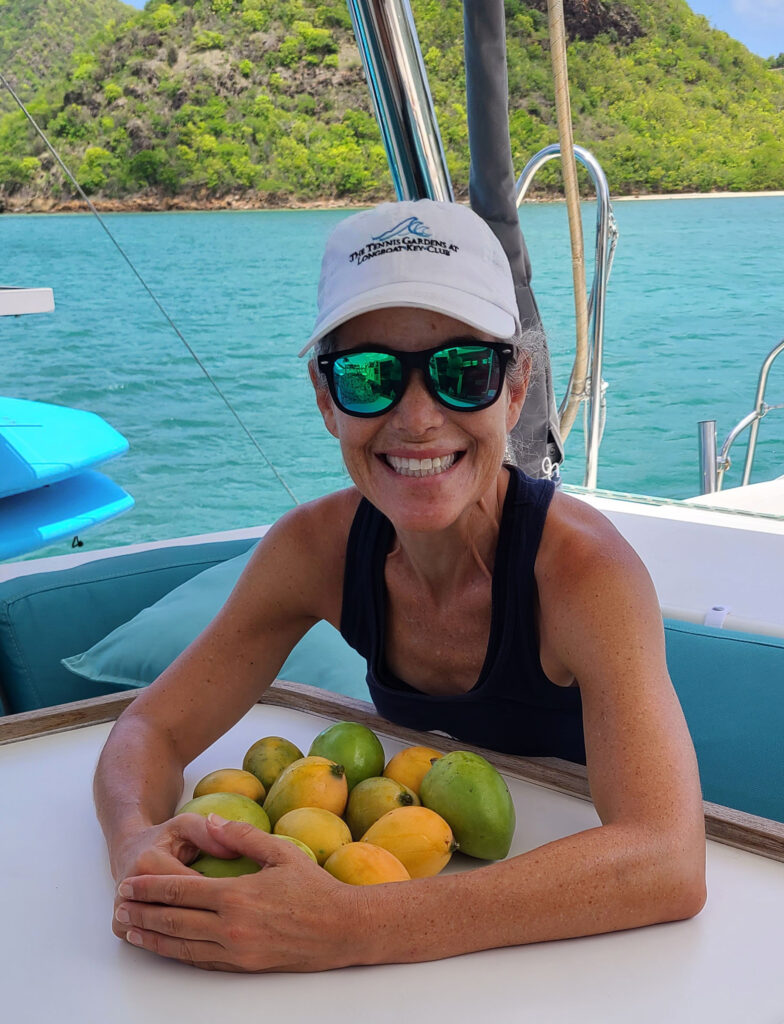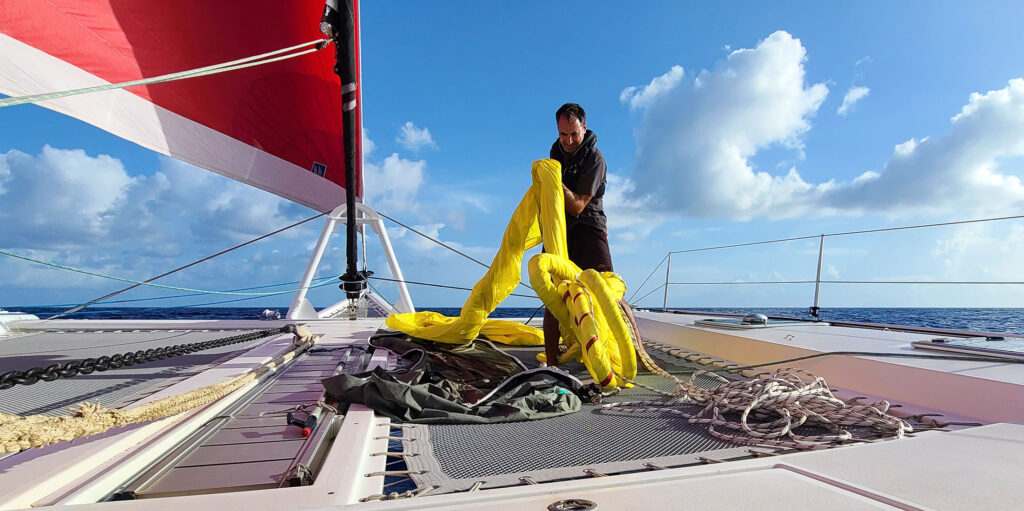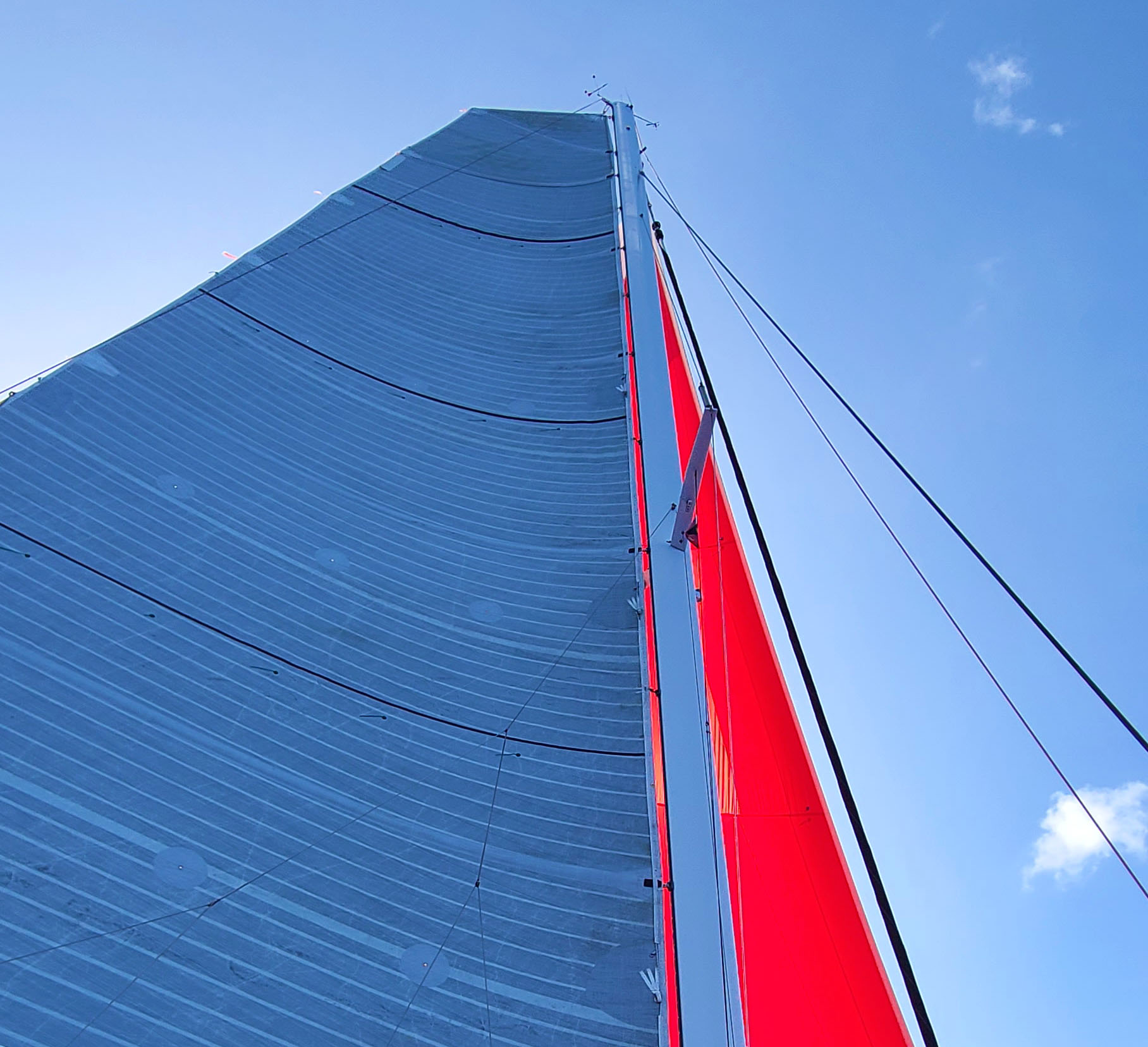A Long Interview with the Captain (warning: technical)
Question: How do Michael and I sail both Gerty’s from Antigua to Rhode Island?
Answer: We don’t.
We expected to be the unfortunate owners of two boats for a short time, and that time is now. So we made a plan with Pete, our friend and broker, from Swiftsure. On May 11, Pete and his crew, Gabriel, departed Antigua on Gerty, Allures 45.9.

Then Michael and I followed them on Gerty, Outremer 49. Averaging over 9 knots in under 12 knots AWS, we passed Gerty Allures within the first hours and haven’t looked back. There’s no doubt team Pete is on the newer, stronger, impeccably maintained boat, but on the Outremer, we’re FAST.
It’s day three of our passage, and we’re settling into the sea. Thanks to the local man who sold me ten freshly picked mangoes for 10EC and threw in five more for free, we’ll be tasting Antigua for a while.

What they say about catamarans is true, by the way. You can leave the mangoes in a bowl on the table, and they won’t slide off, crash to the floor and splatter into a gooey orange mess. Make no mistake. We’re moving (pitching, yawing, etc.) but not heeling. So the infamous monohull tilt is gone, and in a word, I feel level.
This morning the wind dropped and moved behind us. So, Michael swapped the Code D for an asymmetrical spinnaker. As newbies to this boat, the sail change took us two hours! Afterward, my captain, who did the last night watch before he worked in the blistering sun, promptly fell asleep.

When he wakes up, I’m going to interview him.
Jill: Welcome to the blue! How did you sleep?
Michael: Like a rock.
Jill: Let’s start with the good stuff. Why did we make the switch from 2017 Allures 45.9 to 2011 Outremer 49?
My answer is speed, space, convenience and perhaps a little stupidity. If it wasn’t anchored nearby in our favorite kite spot, we would never have entertained the idea of letting go of our Allures. So, I guess a better question for you is, what is it about this boat that sold us?
Michael: Curiosity. I was curious. That’s why we bought it. Seems like a silly reason to buy a boat, but it’s true. Also, we typically like boat projects. Gerty 1 was perfect for us. Hence, no more projects to do there.
You could say the most compelling thing about the Outremer is her speed, but that would be simplistic and incomplete. The real advantage is that you can get her moving faster in less wind. Less wind means smaller waves, lighter loads, and less burden on the crew. To me that’s the benefit. We used to look for weather windows and if it was blowing 12, we would wait for 20. Like right now, it’s blowing 13 knots from behind us. On our Allures we’d be going 5 knots at most. We’re currently going 9 knots on the Outremer. It’s a big difference. But again, we wouldn’t have bought her just to get there faster. It’s the added safety that comes with speed in light conditions. Also, we didn’t love the passages, but we love everything else about the lifestyle. Our hope is that this boat will make our passages better. So far it seems to be working. Because we’re going so much faster and further in the good conditions, good becomes a higher percentage of the trip.
Of course, there were other reasons we made the switch. Affordability of the 2011 model was one. Sure, we knew an older, bigger boat would be a lot of work, but we were up for the task.
Unfortunately, it has more problems than we anticipated, but yeah, we knew. We also knew the previous owner invested money in some basic things that make a difference. For example, she’s got a new carbon fiber mast, 3DI sails, and lithium batteries. In addition, the previous owner replaced the saildrives and had the heat exchangers and engine elbows serviced.
That said, everything that wasn’t replaced needs to be fixed. Now that I think about it, almost all of the problems are plumbing related. So the whole plumbing system is shot. And the heating system as well.
Jill: So without even trying, we’ve made our way to the gritty part of this interview. Tell me about the major boat projects you’ve done thus far on Gerty Outremer. What was involved? And did you know prior to purchase it needed to be fixed?
Michael: Well, let’s start with our most recent disaster—false engine failure. False because a broken fuel gauge caused us to run out of gas. So, no I wasn’t aware of the problem. That said, I knew the dual Racor fuel filter was trouble before we bought the boat because it came up on inspection. Since it was empty, I snatched my opportunity to service it before we filled up with gas again. As you know, we worked in the blazing hot sun for the remainder of the day on this.
Honestly, I can’t remember all the projects I’ve done over the past six weeks.
Jill: That’s okay because I’ve been keeping track. Tell me about the emergency hatch fiasco.
Michael: They’re seized shut. I tried to loosen a handle and the acrylic lens cracked. So we stopped what we were doing immediately, I sealed the acrylic, and put a grab-and-go crowbar in place. Obviously, this still needs to be addressed.
Commercial Break: The soft shackle holding the asymmetrical spinnaker to the bowsprit broke, the cam cleat and hard shackle on the preventer broke, and the 1:1 spinnaker halyard chafed. A chafed halyard is a dysfunctional halyard. So, no more fancy sails until we fix it. Michael is measuring a replacement line now.
Jill: Back to boat projects. There was the bowsprit reconfiguration, the new watermaker install, the AC removals, the prep-work for a new holding tank, the Y-valve replacement, the refrigerator and freezer repairs, the shower drain and water pressure pump swaps, multiple electrical line overhauls, SSB removal, Port forward cabin carpentry, sail locker vent service, bottom cleaning, rebuilding of the fuel polishing system—
Michael: And don’t forget that time I had to take apart the oven, or all the work you’ve done on your own—the hatch service, maintenance and repair of all the electrical fans, the grill, door locks, and hardcore scrubbing the interior walls.
We also reorganized the entire boat. Some things were just weird. The previous owner stored the oil changing gear under his bed. Of course, I moved that stinky stuff. We took a week to get rid of things that I guess accumulated over time. He had twenty-one dock lines! We kept ten. And I know you gave away about five jars of peanut butter, explaining to me that we still had three jars left and storage was an issue.
Jill: (laughing) I like peanut butter, but a girl can’t live on it.
Commercial Break: Time to prepare for an upcoming front. It’s not possible to go around it because it stretches the width of the entire Atlantic Ocean, so our strategy is to be ready for it. We’ll ride the back side of it and our first reef is already in.

Jill: For the sailors, can you give me the back story on the watermaker?
Michael: Well, as you know, the water maker failure was unexpected. We knew it was original to the boat, but I hoped we could get a lot more years out of it.
The first time we used it the high pressure membranes leaked in four different spots. I took the problem areas apart to service them, but when I put everything back together the damn thing was leaking from different spots.
The damage was extensive—cracked end caps, gaskets failing, high pressure hoses falling apart, etc.
We could’ve replaced the parts and got it operational without leaks. However it seemed like a poor investment considering that the motors and control panel were thirteen years old and had rust damage. Most people with the Dessalator duo 100 get them because they have dual motors. One for DC and one for AC. If you have a generator it means you can run the watermaker off the generator or off the batteries. We don’t have a generator and don’t plan to get one, so it’s unlikely we would ever use the AC motor.
Gerty Allures has an Echotec 780 DML which we found simpler, more robust and easier to service than the Dessalator Duo 100. Plus it has a 20% higher output. True, the Dessalator is fancier with an automated TDS sensor and flush cycle, but we don’t mind having to turn a few levers, test the water manually, and have fewer parts to break. So, after I finagled an enticing discount, we bought an Echotec and installed it.
Jill: Excuse me, but I must give credit where credit is due. YOU installed it and I am forever grateful. Now, elaborate a bit about the holding tanks, please
Michael: The holding tank project is far from finished. I’ve prepped her for a new port side system and ordered a tank and head (toilet) shipped to Rhode Island. We knew prior to purchase this would need to be done because we wanted the electric flush, fresh water system we had on Gerty Allures. However, we didn’t know the starboard side Y-valve was seized, making it impossible to divert sewage to the holding tank. We’re not into dumping in an anchorage for obvious reasons, so it was the first thing I repaired on the boat. The new Y-valve worked, but things went south from there.
The system started leaking into the bilge! A smelly nightmare, that made the starboard side head incompatible with use and the port side reconstruction even more timely. The plan is to eliminate the inoperable Electrosan and put in a 30 gallon gravity discharged holding tank behind the hanging locker. It will take up a small storage space in the salon, but I think it’s well worth the sacrifice.
Jill: I agree, especially because you’ve created a bigger, more accessible storage space in the now port side pantry. Should we talk about the dinghy?
Michael: The dinghy is an OC tender 350. It’s a great dinghy, but as you know, we’ve been having some growing pains. There was a problem with fuel tank that day you had to row half-way across Freeman’s bay to the grocery store. The pick up tube fell out of the tank, so you had to turn the tank on it’s side to get the damn thing going again. There was also a learning curve regarding the motor. Starting and hoisting it were a struggle at first. I know we both think the 350 is too big. One size smaller would be ideal—less windage, smaller motor, easier for us to manage, and still plenty of room for guests. Maybe we can trade with someone in the future.
Jill: I miss Love Bug.
Michael: I know you do, but I also know you’ll find a way to bedazzle this dinghy and make it your own.
Jill: Thank you for taking me sailing.


That’s a whole lot of work. I had no idea. Glad it’s all ship shape now
Yup, sure is a lot of work… seems to me boats are that way… just like a house, and it is your house! I have to say that I definitely like the smoother and more stable ride on new Gerty.
Enjoyed this start up interview for the new boat!